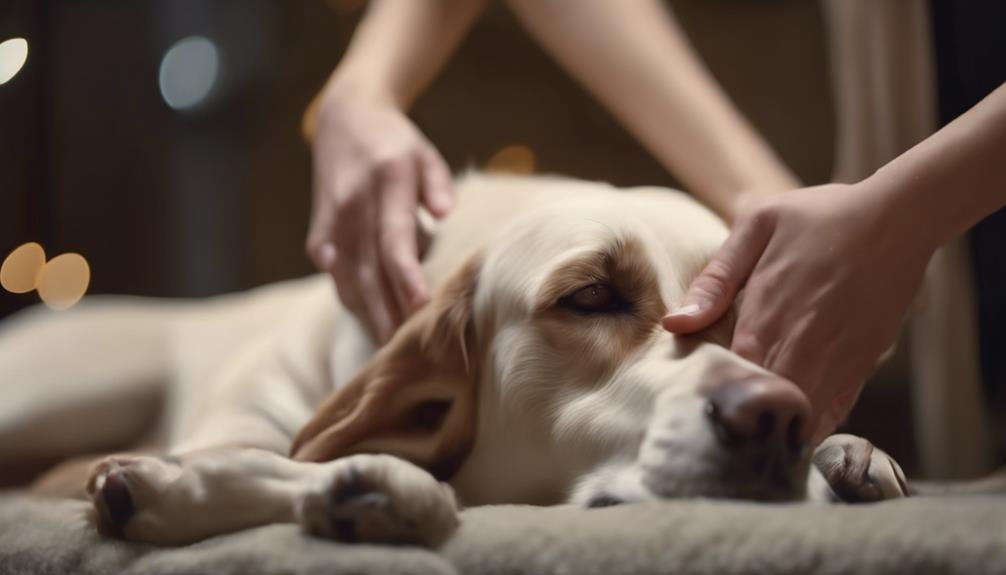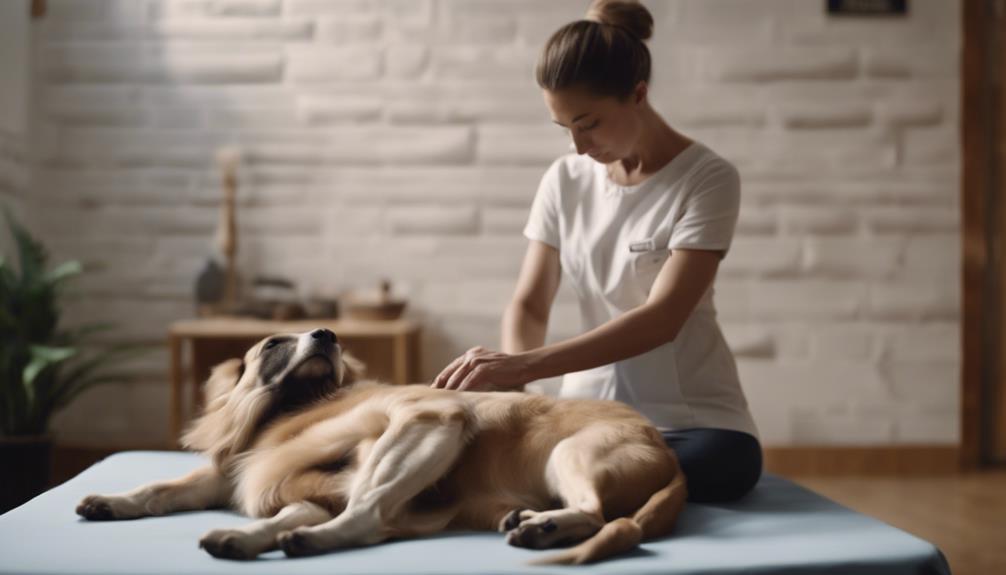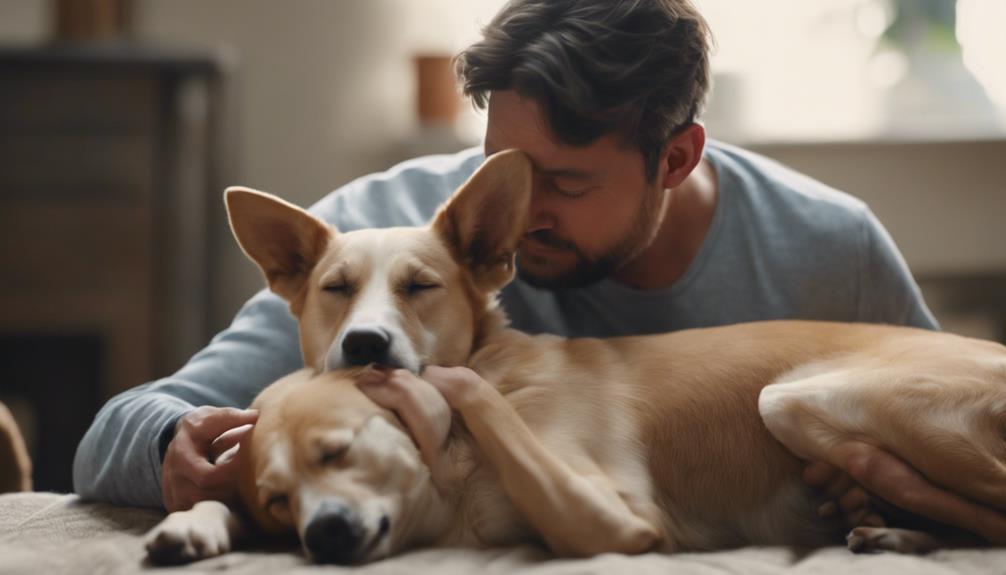Imagine coming home after a long day, and your dog greets you with a wagging tail and eager eyes. You've heard about the benefits of dog massages, but where do you start?
Understanding how to massage your dog not only fosters relaxation and well-being but also deepens the bond between you and your furry friend. By incorporating simple techniques and learning about the positive impact massages can have on your pup's health, you can create a calming and therapeutic experience for both of you.
So, are you ready to explore the world of dog massages and discover their potential benefits for your canine companion?
Key Takeaways
- Dog massages benefit relaxation, pain relief, and rehabilitation.
- Different types cater to anxiety relief, pain management, and more.
- Safe techniques include moderate pressure and vet consultation.
- Cost considerations range from $40 to $100 per hour for professional services.
Benefits of Dog Massages
Massage your dog to provide relaxation, pain relief, and rehabilitation, as they enjoy the benefits of this calming and therapeutic practice. Dogs find massages soothing, aiding in anxiety relief, pain management, and behavior control. Whether recovering from an injury or surgery, massages can assist in rehabilitation.
Older dogs, especially those with chronic conditions like arthritis, benefit greatly. The gentle touch and pressure help improve circulation, reduce muscle tension, and promote overall well-being. Before starting, it's essential to consult with a veterinarian to ensure the massage aligns with your dog's specific needs.
Regular massages can contribute to your dog's health and happiness, helping them lead a more comfortable and active life.
Importance of Veterinarian Consultation
Before proceeding with any massage techniques for your furry friend, ensure that you prioritize consulting with a veterinarian to guarantee the safety and appropriateness of the massage for your dog's specific needs. It's essential to seek professional advice to ensure the well-being of your pup. Here are some key reasons why veterinarian consultation is crucial:
- Your vet can identify any underlying health conditions that may affect the massage.
- They can provide guidance on suitable massage techniques based on your dog's age and health status.
- Veterinarians can recommend specialized massages for specific conditions like arthritis or injury recovery.
- They'll advise on any precautions or modifications needed during the massage session.
- Consulting with a vet ensures that the massage will be beneficial and safe for your dog.
Types of Dog Massages
When catering to your dog's well-being through massage, consider the various types of techniques available to address specific needs and promote relaxation. Here are some common types of dog massages:
| Type of Massage | Description |
|---|---|
| Relaxation Massages | Aimed at providing overall relaxation and stress relief for your pup. Helps in bonding and calming. |
| Anxiety Relief Massages | Specifically designed to reduce anxiety levels in dogs, promoting a sense of security and comfort. |
| Pain Management Massages | Focused on alleviating discomfort from various sources such as arthritis, muscle soreness, or injuries. |
Understanding these massage types can help you choose the most suitable technique to enhance your dog's well-being and strengthen your bond.
Professional Pet Massage Services
Consider seeking out professional pet massage services to ensure the best care and expertise for your furry companion's well-being. Here are some benefits of opting for professional pet massage services:
- Professional pet massage therapists are trained in specific techniques for different purposes.
- They can tailor the massage session to address your dog's individual needs and health conditions.
- Professional services provide a safe and controlled environment for the massage.
- You can learn from the experts about how to continue promoting relaxation and well-being at home.
- Regular sessions with a professional can contribute to your dog's overall health and happiness.
Safe Dog Massage Techniques

To ensure a safe and effective dog massage, focus on using moderate pressure and avoiding sensitive areas. Use gentle movements and pay attention to your dog's reactions. Here are some safe dog massage techniques to follow:
| Safe Techniques | Description |
|---|---|
| Use moderate pressure | Apply firm but gentle pressure during the massage. |
| Avoid sensitive areas | Stay away from areas like the spine and joints. |
| Observe for discomfort | Watch for signs of discomfort or pain in your dog. |
| Focus on surrounding regions | If your dog has painful areas, massage around them. |
Avoiding Discomfort During Massage
Ensure your dog's comfort and relaxation during a massage by paying close attention to their body language and responses. It's essential to avoid discomfort during the massage to make the experience enjoyable for your pup.
Here are some tips to help you achieve that:
- Start with gentle pressure and adjust based on your dog's reaction.
- Watch for signs of tension, such as flinching or pulling away.
- Avoid sensitive areas like joints or wounds.
- If your dog seems uncomfortable, stop and try a different approach.
- Always communicate with your dog through soothing words and gentle touch.
Health Conditions Helped by Massages

Dog massages can significantly benefit various health conditions such as hip dysplasia, arthritis, and neurological issues. Massaging can help improve circulation, reduce inflammation, and alleviate pain in dogs with these conditions.
For example, in dogs with hip dysplasia, gentle massages can aid in increasing flexibility and relieving muscle tension around the hip joint. Arthritic dogs can experience decreased stiffness and improved mobility through targeted massage techniques.
Additionally, dogs with neurological issues may benefit from massages that focus on stimulating blood flow and promoting relaxation. Regular massages can contribute to the overall well-being of your pup by helping manage these health conditions effectively.
Always consult with a professional to ensure the massage is tailored to your dog's specific needs.
Rehabilitation and Pain Management
When aiding your dog's rehabilitation and managing their pain, employing proper massage techniques is essential for promoting healing and relief. Here are some tips to help you effectively assist your pup in their recovery process:
- Focus on gently massaging the affected areas to promote circulation and reduce stiffness.
- Use slow and deliberate motions to prevent any further discomfort or injury.
- Pay attention to your dog's body language for cues on where they might be experiencing the most pain.
- Consult with your veterinarian to create a tailored massage plan that suits your dog's specific needs.
- Incorporate massage sessions into your dog's routine to provide consistent pain management and support throughout their rehabilitation journey.
Cost of Dog Massages

Considering the range of $40 to $100 per hour, the cost of dog massages can vary depending on the duration and relaxation needs of your pet. Factors such as the expertise of the masseuse, location, and specific techniques used can also influence the price.
The duration of the massage session, whether it's a quick relaxation massage or a more intensive therapy session, will contribute to the final cost. While some may see dog massages as a luxury, they can provide numerous benefits for your furry friend's overall well-being.
It's essential to weigh the cost against the potential benefits and consider investing in your dog's comfort and health.
Pricing and Considerations
For a comprehensive understanding of dog massage pricing and important considerations, evaluate the quality and duration of the service provided. When considering dog massage services, keep the following in mind:
- Check the range of prices, typically $40 to $100 per hour.
- Consider variations in cost based on the time required for your dog to relax.
- Verify the legality of pet massage services in your state.
- Seek recommendations from a veterinarian for professional services.
- Ensure your dog's comfort and enjoyment are the top priorities during the massage session.
Legalities of Pet Massage Services

To ensure the legality and compliance of pet massage services in your area, it is important to verify the regulations governing such practices. Before seeking professional pet massage services, check if it is permitted by law. Here is a brief comparison to give you an idea of what to look out for:
| Legal Aspect | Importance |
|---|---|
| Licensing | Ensures trained professionals handle your pet. |
| Liability Insurance | Protects both you and the massage therapist in case of accidents. |
| Local Regulations | Compliance with local laws guarantees a safe and legal service. |
Understanding these aspects will help you make informed decisions about pet massage services in your area.
Ensuring Your Dog's Comfort
Ensuring your dog's relaxation during a massage session is paramount for a positive and effective experience. To make sure your pup is comfortable during the massage, consider the following:
- Choose a quiet and familiar environment for the massage.
- Use gentle and soothing strokes to help your dog relax.
- Pay attention to your dog's body language for signs of enjoyment or discomfort.
- Allow breaks if your dog seems restless or agitated.
- Offer treats or verbal praise to create a positive association with the massage experience.
Maximizing Massage Benefits

To maximize the benefits of dog massages, focus on understanding your pet's needs and preferences. By paying attention to what your dog enjoys and how they respond to different techniques, you can tailor the massage experience to suit them best. Here's a helpful guide to help you enhance the benefits of dog massages:
| Focus on Needs | Tailor Techniques | Observe Reactions |
|---|---|---|
| Identify areas of tension or discomfort. | Adjust pressure and speed to suit your dog. | Watch for signs of relaxation or discomfort. |
| Use calming strokes in preferred areas. | Incorporate gentle stretches if beneficial. | Note any changes in behavior during the massage. |
| Offer breaks if your dog becomes restless. | Experiment with different techniques. | Respect your dog's cues and boundaries. |
Conclusion
Now that you have learned about the benefits of dog massages and how to safely incorporate them into your routine, you and your pup can enjoy the relaxing and bonding experience together.
Remember to consult with your veterinarian, use safe techniques, and consider professional services for maximum benefits.
By incorporating regular massages, you can improve your dog's overall well-being and strengthen your bond with them.
Give your furry companion the gift of relaxation and comfort through the art of dog massage.




